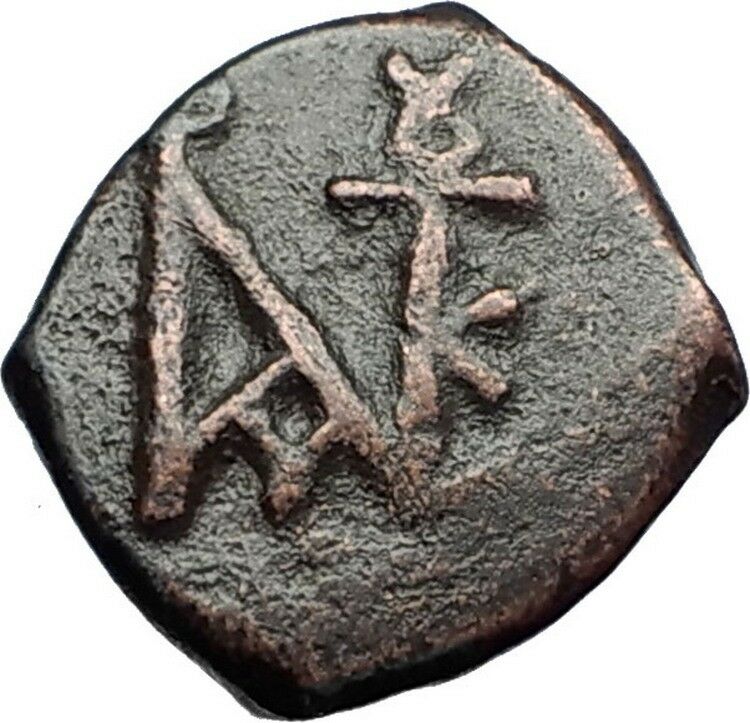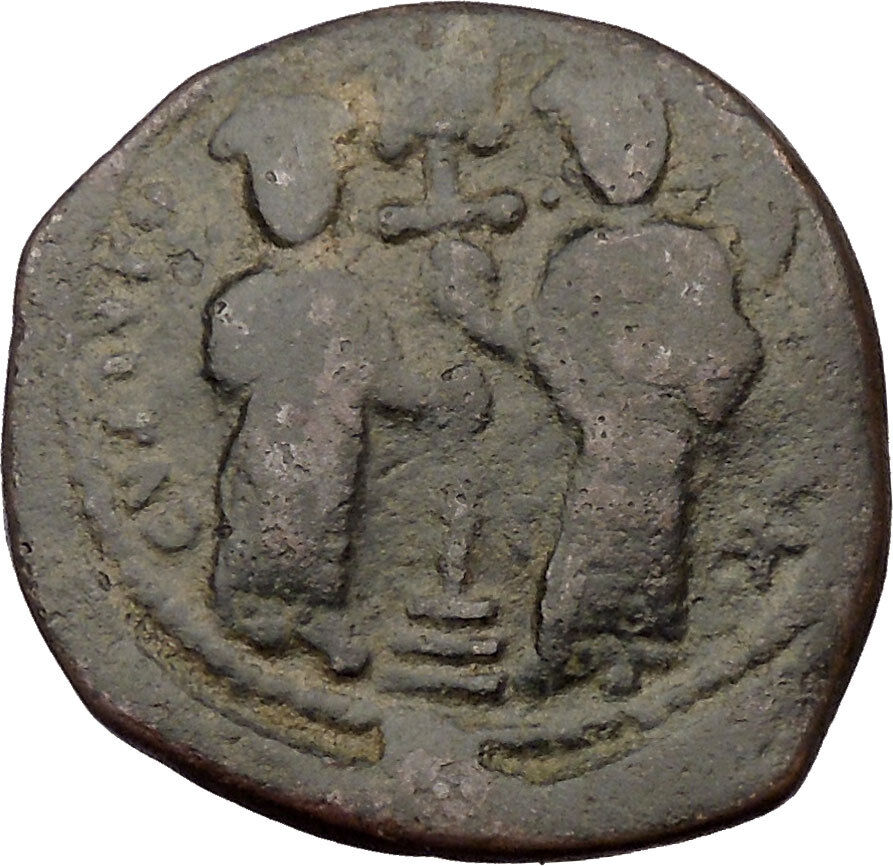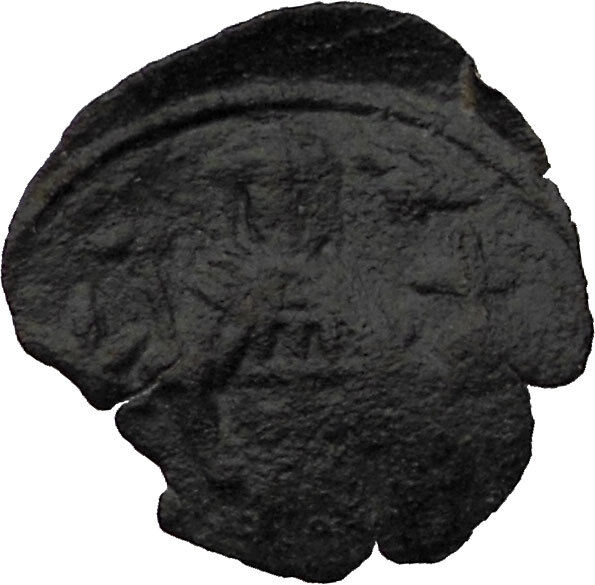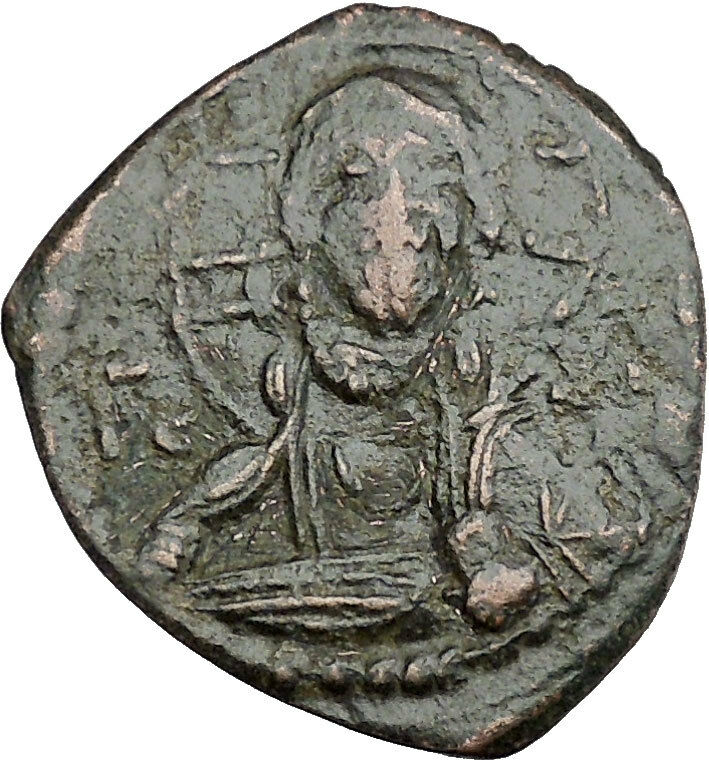|
Byzantine Empire
Constantine IV, Pogonatus – Emperor: July 15, 668 – July 10, 685 A.D.
CONSTANTINE IV POGONATUS with HERACLIUS and TIBERIUS
Silver Hexagram 22mm (5.59 grams) Constantinople mint
Reference: Sear 1170.
Helmeted and cuirassed bust facing slightly right, holding spear and shield decorated with horseman motif.
Cross potent set upon globus and three steps; at sides, Heraclius and Tiberius standing facing, each holding globus cruciger.
You are bidding on the exact item pictured, provided with a Certificate of Authenticity and Lifetime Guarantee of Authenticity.
Constantine IV, (c. 652 – September 685), sometimes incorrectly called Pogonatos, “the Bearded”, by confusion with his father; was Byzantine Emperor from 668 to 685. His reign saw the first serious check to nearly 50 years of uninterrupted Islamic expansion, while his calling of the Sixth Ecumenical Council saw the end of the monothelitism controversy in the Byzantine Empire.
The eldest son of Constans II, Constantine IV had been named a co-emperor with his father in 654. He had been given the responsibility of managing the affairs at Constantinople during his father’s extended absence in Italy and became senior Emperor when Constans was assassinated in 668. His mother was Fausta, daughter of patrician Valentinus. The first task before the new Emperor was the suppression of the military revolt in Sicily under Mezezius which had led to his father’s death. Within 7 months of his accession, Constantine IV had dealt with the insurgency with the support of Pope Vitalian. But this success was overshadowed by troubles in the east.
As early as 668 the Caliph Muawiyah I, after receiving an invitation from Saborios, the commander of the troops in Armenia to help him overthrow the Emperor at Constantinople, sent an army under his son Yazid against the Eastern Roman Empire. Yazid reached as far as Chalcedon and took the important Byzantine center Amorion. Although the city was quickly recovered, the Arabs next attacked Carthage and Sicily in 669. In 670 the Arabs captured Cyzicus and set up a base from which to launch further attacks into the heart of the Empire. Their fleet captured Smyrna and other coastal cities in 672. Finally, in 672, the Arabs sent a large fleet to attack Constantinople by sea. While Constantine was distracted by this, the Slavs unsuccessfully attacked Thessalonika.
The Siege of Constantinople: 674-678
Then, commencing in 674, the Arabs launched the long awaited siege of Constantinople. The great fleet that had been assembled set sail under the command of Abdu’l-Rahman ibn Abu Bakr before the end of the year; and during the winter months some of the ships anchored at Smyrna, the rest off the coast of Cilicia. Additional squadrons reinforced the forces of Abd ar-Rahman before they proceeded to the Hellespont, into which they sailed in about April 674. From April to September 674 the fleet lay moored from the promontory of Hebdomon, on the Propontis, as far as the promontory of Kyklobion, near the Golden Gate, and throughout those months continued to engage with the Byzantine fleet which defended the harbour continued from morning to evening.
Knowing that it was only a matter of time before Constantinople was under siege, Constantine had ensured that the city was well provisioned. He also constructed a large number of fireships and fast-sailing boats provided with tubes or siphons for squirting fire. This is the first known use of Greek fire in combat, which was one of the key advantages that the Byzantines possessed. In September, the Arabs having failed in their attempts to take the city, sailed to Cyzicus, which they made their winter quarters. Over the following five years, the Arabs would return each spring to continue the siege of Constantinople, but with the same results. The city survived and finally in 678, the Arabs were forced to raise the siege. The Arabs withdrew, and were almost simultaneously defeated on land in Lycia in Anatolia. This unexpected reverse forced Muawiyah I to seek a truce with Constantine. The terms of the concluded truce required the Arabs to evacuating those islands in the Aegean they had seized, as well as an annual tribute to the Emperor consisting of fifty slaves, fifty horses and 3,000 pounds of gold. The raising of the siege allowed Constantine to go to the relief of Thessalonika, still under siege from the Slavs.
Later Reign
With the temporary passing of the Arab threat, Constantine had to turn his attention to the Church, torn between Monothelitism and Orthodoxy. In November 680 Constantine convened the Sixth Ecumenical Council (also known as the Third Council of Constantinople). Constantine presided in person during the formal aspects of the proceedings (the first eleven sittings and then the eighteenth), surrounded by his court officials, but took no active role in the theological discussions. The Council reaffirmed the Orthodox doctrines of the Council of Chalcedon in 451. This solved the controversy over monothelitism; conveniently for the Empire, most monothelites were now under the control of the Umayyad Caliphate. The council closed in September 681.
Due to the ongoing concerns with the Arabs during the 670s, in the west, Constantine had been forced to conclude treaties with the Lombards, who had captured Brindisi and Taranto. As well, in 670 the Bulgars under Asparukh crossed the Danube into nominally Imperial territory and began to subject the local communities and Slavic tribes. In 680, Constantine IV led a combined land and sea operation against the invaders and besieged their fortified camp in Dobruja. Suffering from bad health, the Emperor had to leave the army, which allowed itself to panic and be defeated by the Bulgars. In 681, Constantine was forced to acknowledge the Bulgar state in Moesia and to pay protection money to avoid further inroads into Byzantine Thrace. Consequently, Constantine created the Theme of Thrace.
His brothers Heraclius and Tiberius had been crowned with him as Augusti during the reign of their father, and this was confirmed by the demand of the populace, but in 681 Constantine had them mutilated so they would be ineligible to rule. At the same time he associated on the throne his own young son Justinian II. Constantine died of dysentery in September 685.
Family
By his wife Anastasia, Constantine IV had at least two sons:
- Justinian II, who succeeded as emperor
- Heraclius
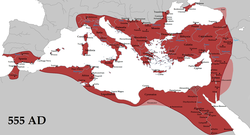 The Byzantine Empire, or Eastern Roman Empire, was the predominantly Greek-speaking eastern half continuation and remainder of the Roman Empire during Late Antiquity and the Middle Ages. Its capital city was Constantinople (modern-day Istanbul), originally founded as Byzantium. It survived the fragmentation and fall of the Western Roman Empire in the 5th century AD and continued to exist for an additional thousand years until it fell to the Ottoman Turks in 1453. During most of its existence, the empire was the most powerful economic, cultural, and military force in Europe. Both “Byzantine Empire” and “Eastern Roman Empire” are historiographical terms created after the end of the realm; its citizens continued to refer to their empire as the Roman Empire (Ancient Greek: Βασιλεία Ῥωμαίων, tr. Basileia Rhōmaiōn; Latin: Imperium Romanum), or Romania (Ῥωμανία), and to themselves as “Romans”. The Byzantine Empire, or Eastern Roman Empire, was the predominantly Greek-speaking eastern half continuation and remainder of the Roman Empire during Late Antiquity and the Middle Ages. Its capital city was Constantinople (modern-day Istanbul), originally founded as Byzantium. It survived the fragmentation and fall of the Western Roman Empire in the 5th century AD and continued to exist for an additional thousand years until it fell to the Ottoman Turks in 1453. During most of its existence, the empire was the most powerful economic, cultural, and military force in Europe. Both “Byzantine Empire” and “Eastern Roman Empire” are historiographical terms created after the end of the realm; its citizens continued to refer to their empire as the Roman Empire (Ancient Greek: Βασιλεία Ῥωμαίων, tr. Basileia Rhōmaiōn; Latin: Imperium Romanum), or Romania (Ῥωμανία), and to themselves as “Romans”.
Several events from the 4th to 6th centuries mark the transitional period during which the Roman Empire’s east and west divided. In 285, the emperor Diocletian (r. 284-305) partitioned the Roman Empire’s administration into eastern and western halves. Between 324 and 330, Constantine I (r. 306-337) transferred the main capital from Rome to Byzantium, later known as Constantinople (“City of Constantine”) and Nova Roma (“New Rome”). Under Theodosius I (r. 379-395), Christianity became the Empire’s official state religion and others such as Roman polytheism were proscribed. And finally, under the reign of Heraclius (r. 610-641), the Empire’s military and administration were restructured and adopted Greek for official use instead of Latin. Thus, although it continued the Roman state and maintained Roman state traditions, modern historians distinguish Byzantium from ancient Rome insofar as it was oriented towards Greek rather than Latin culture, and characterised by Orthodox Christianity rather than Roman polytheism.
The borders of the Empire evolved significantly over its existence, as it went through several cycles of decline and recovery. During the reign of Justinian I (r. 527-565), the Empire reached its greatest extent after reconquering much of the historically Roman western Mediterranean coast, including north Africa, Italy, and Rome itself, which it held for two more centuries. During the reign of Maurice (r. 582-602), the Empire’s eastern frontier was expanded and the north stabilised. However, his assassination caused a two-decade-long war with Sassanid Persia which exhausted the Empire’s resources and contributed to major territorial losses during the Muslim conquests of the 7th century. In a matter of years the Empire lost its richest provinces, Egypt and Syria, to the Arabs.
During the Macedonian dynasty (10th-11th centuries), the Empire again expanded and experienced a two-century long renaissance, which came to an end with the loss of much of Asia Minor to the Seljuk Turks after the Battle of Manzikert in 1071. This battle opened the way for the Turks to settle in Anatolia as a homeland.
The final centuries of the Empire exhibited a general trend of decline. It struggled to recover during the 12th century, but was delivered a mortal blow during the Fourth Crusade, when Constantinople was sacked and the Empire dissolved and divided into competing Byzantine Greek and Latin realms. Despite the eventual recovery of Constantinople and re-establishment of the Empire in 1261, Byzantium remained only one of several small rival states in the area for the final two centuries of its existence. Its remaining territories were progressively annexed by the Ottomans over the 15th century. The Fall of Constantinople to the Ottoman Empire in 1453 finally ended the Byzantine Empire.
|





 The Byzantine Empire, or Eastern Roman Empire, was the predominantly Greek-speaking eastern half continuation and remainder of the Roman Empire during Late Antiquity and the Middle Ages. Its capital city was Constantinople (modern-day Istanbul), originally founded as Byzantium. It survived the fragmentation and fall of the Western Roman Empire in the 5th century AD and continued to exist for an additional thousand years until it fell to the Ottoman Turks in 1453. During most of its existence, the empire was the most powerful economic, cultural, and military force in Europe. Both “Byzantine Empire” and “Eastern Roman Empire” are historiographical terms created after the end of the realm; its citizens continued to refer to their empire as the Roman Empire (Ancient Greek: Βασιλεία Ῥωμαίων, tr. Basileia Rhōmaiōn; Latin: Imperium Romanum), or Romania (Ῥωμανία), and to themselves as “Romans”.
The Byzantine Empire, or Eastern Roman Empire, was the predominantly Greek-speaking eastern half continuation and remainder of the Roman Empire during Late Antiquity and the Middle Ages. Its capital city was Constantinople (modern-day Istanbul), originally founded as Byzantium. It survived the fragmentation and fall of the Western Roman Empire in the 5th century AD and continued to exist for an additional thousand years until it fell to the Ottoman Turks in 1453. During most of its existence, the empire was the most powerful economic, cultural, and military force in Europe. Both “Byzantine Empire” and “Eastern Roman Empire” are historiographical terms created after the end of the realm; its citizens continued to refer to their empire as the Roman Empire (Ancient Greek: Βασιλεία Ῥωμαίων, tr. Basileia Rhōmaiōn; Latin: Imperium Romanum), or Romania (Ῥωμανία), and to themselves as “Romans”.

